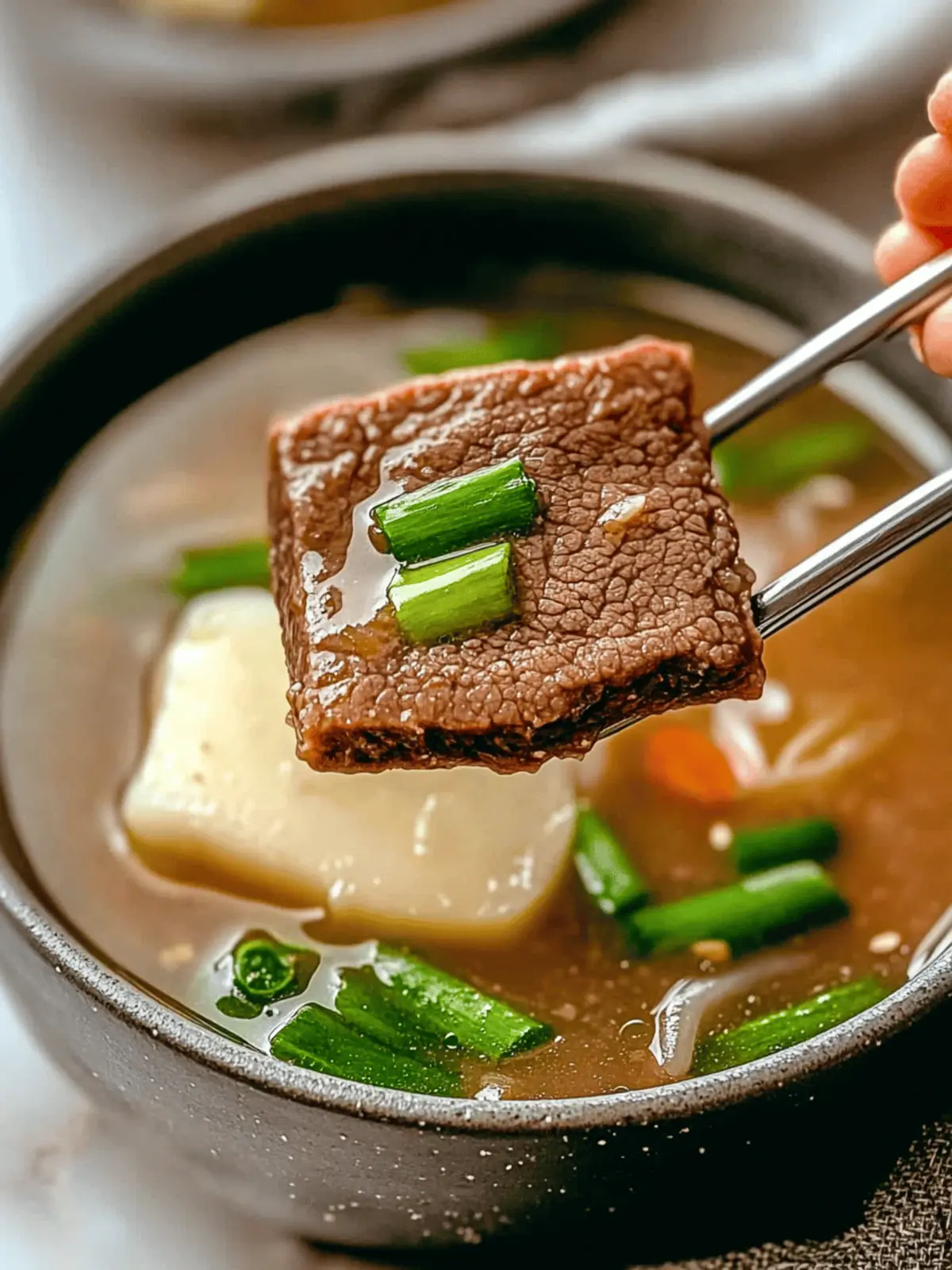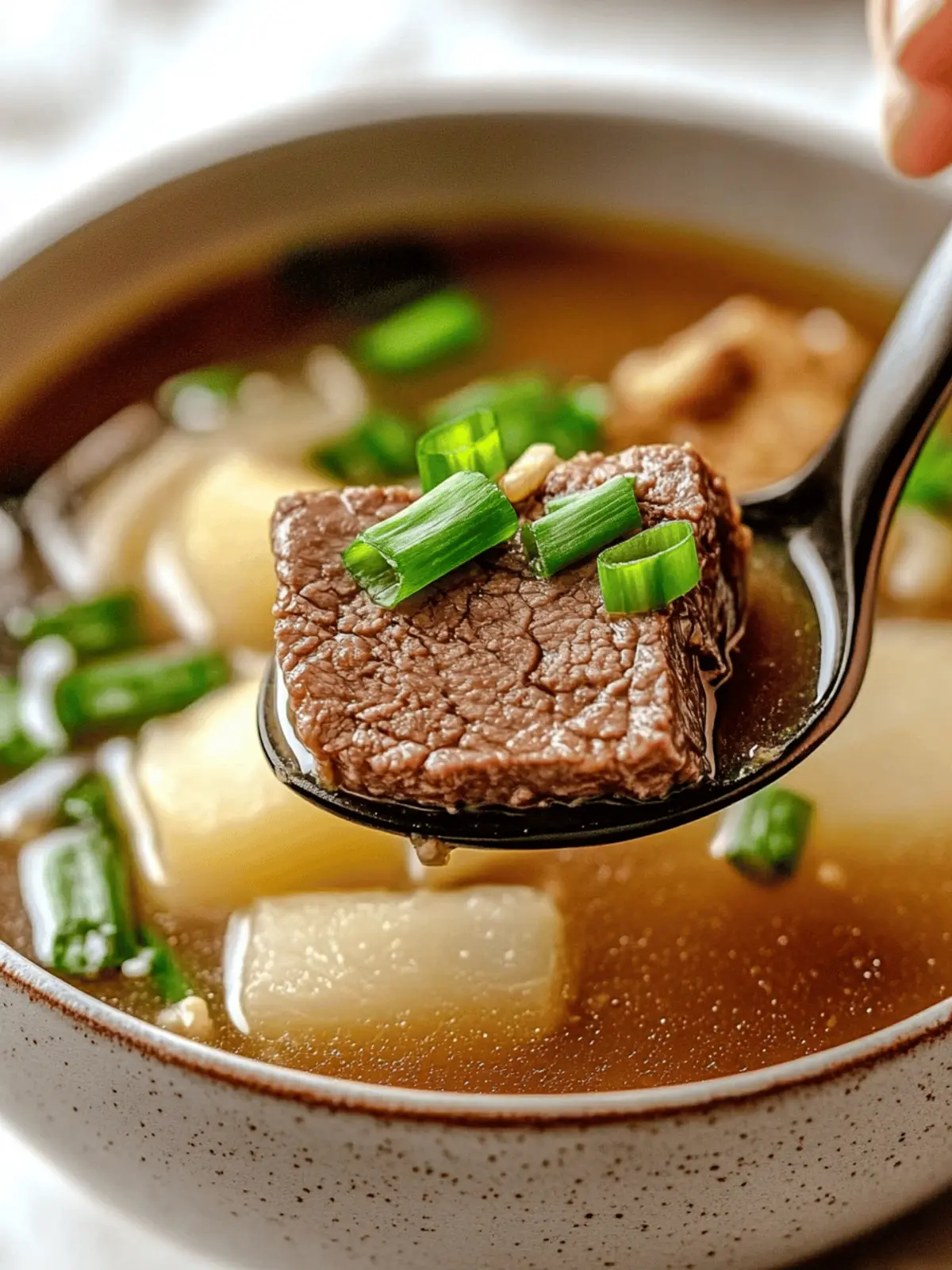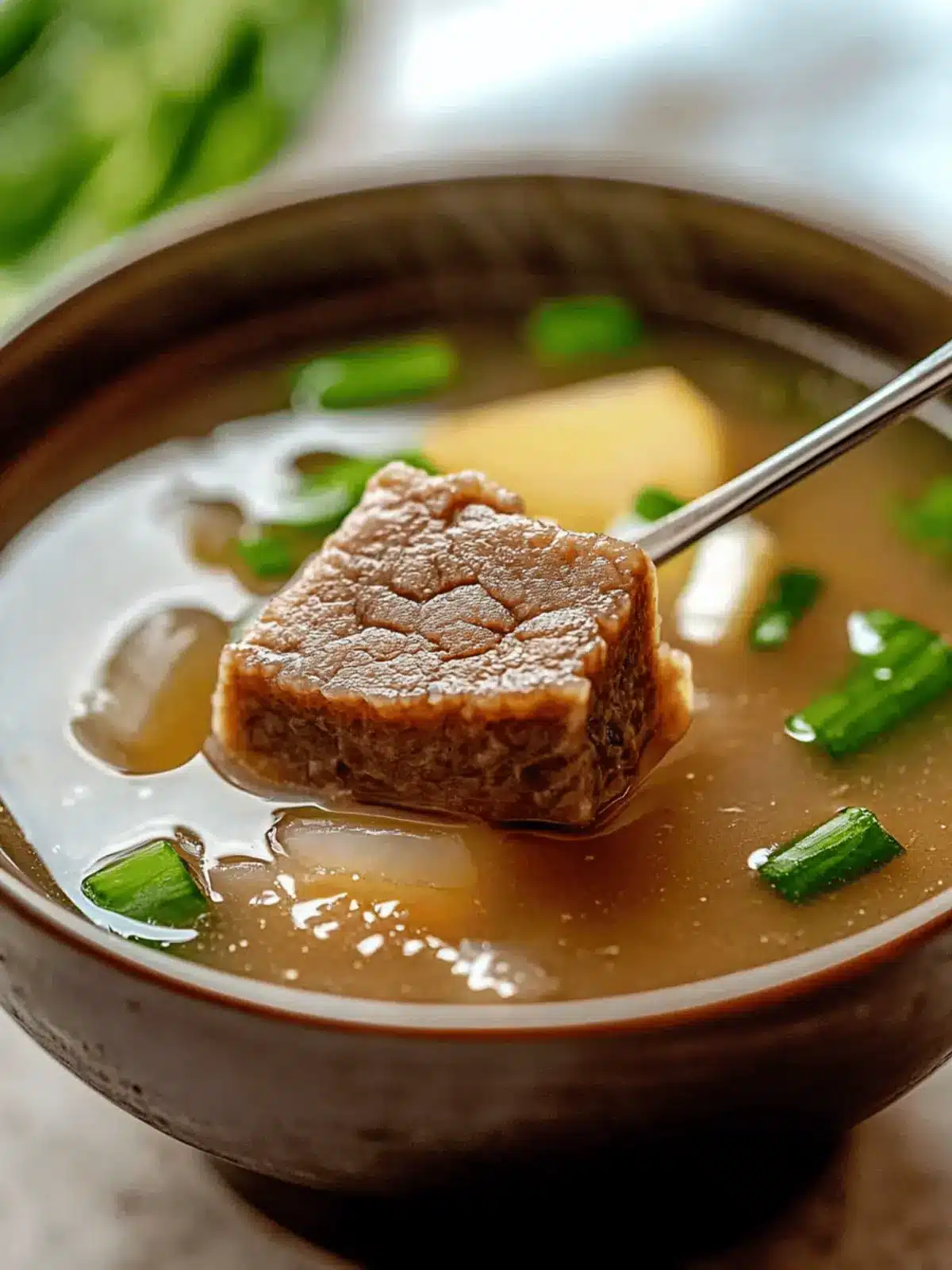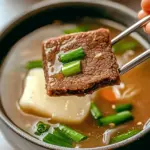As the first chill of winter settles in, I find myself craving the warm embrace of a comforting bowl of Korean winter soup. The rich aroma wafts through my kitchen, a delightful mix of savory beef short ribs, tender tofu, and vibrant vegetables that feels like a hug on a cold evening. It’s remarkable how a few simple ingredients can transform a weeknight dinner into a nourishing experience.
This recipe for cozy Korean winter soup is perfect for those nights when you want something hearty yet uncomplicated. With variations that cater to different dietary preferences, it’s a dish that’s not only versatile but also a guaranteed crowd-pleaser. Whether you’re looking to indulge in beefy goodness or explore vegetarian substitutes, this soup will bring warmth to your table and heart. So grab your pot and let’s dive into a comforting culinary adventure that celebrates the rich flavors of Korean cuisine!
Why is Korean Winter Soup a Must-Try?
Comforting Warmth: This soup wraps you in cozy goodness, perfect for chilly nights.
Flavor Explosion: Each spoonful offers a robust blend of savory beef and aromatic veggies that’ll tantalize your taste buds.
Adaptable Recipe: With easy swaps for ingredients, you can cater to gluten-free and vegetarian diets effortlessly.
Family Favorite: Its rich taste and nourishing qualities make it an instant hit with both adults and kids.
Quick & Easy: You can have a hearty meal ready with minimal fuss – perfect for busy weeknights!
Make it a delightful meal by serving with warm rice and kimchi for that authentic touch.
Korean Winter Soup Ingredients
• Transform your winter nights with this delicious Korean winter soup filled with the warmth and comfort of home-cooked goodness.
For the Broth
- Beef short ribs – A rich protein source that infuses the broth with deep flavor; consider substituting with beef shank or oxtail for a different taste.
- Aromatics (onion, ginger, garlic, green onions) – Essential for building a robust broth; keeping onion skins on enhances the broth’s color.
For the Soup
- Tofu – Adds a creamy texture and protein; opt for firm tofu, or for a vegetarian twist, try large portobello mushrooms or seitan.
- Korean leek – Elevates the soup’s aroma; can be swapped with regular leeks or green onions if needed.
- Radish – Imparts subtle sweetness and soft texture; integral for simmering to enhance the broth.
For Seasoning
- Guk ganjang (Korean soup soy sauce) – Crucial for authentic flavor; if you’re gluten-free, tamari or coconut aminos work well.
With these ingredients on hand, you’re just steps away from enjoying a bowl of Korean winter soup that warms both body and soul!
How to Make Korean Winter Soup
-
Soak the Beef: Begin by soaking the beef short ribs in cold water for 1 hour. This helps draw out any blood, resulting in a cleaner flavor. Alternatively, you can flash boil them, discarding the liquid afterward.
-
Prepare Aromatics: While the beef is soaking, prep the aromatics. Use a whole yellow onion (leave the skin on for richer color), cut some ginger, chop garlic, and slice green onions for later.
-
Combine Ingredients: In a large stock pot, combine the soaked beef short ribs with the prepared aromatics. Pour in 10 cups of water, and bring the mixture to a boil over medium-high heat.
-
Simmer the Broth: Once boiling, reduce the heat to medium. Skim off any foam that rises to the top to maintain a clear broth. Allow it to simmer uncovered for 1 hour.
-
Add Radish: After the broth has simmered, add the radish slices. Continue simmering for an additional 20 minutes until the radish is tender and delicious.
-
Season the Broth: Discard the aromatics now that their flavors have infused. Season your broth with guk ganjang and sea salt to taste, and add in some chopped garlic. Simmer for another 10 minutes.
-
Serve and Garnish: Ladle the warm soup into bowls, garnishing each serving with fresh sliced green onions and a sprinkle of black pepper. For a complete Korean meal, serve with rice on the side.
Optional: Pair with a side of kimchi for an authentic experience!
Exact quantities are listed in the recipe card below.
What to Serve with Korean Winter Soup?
Cozy up your dinner table with delightful sides that enhance the heartwarming experience of this soulful soup.
- Steamed White Rice: A classic accompaniment, it absorbs the rich broth, creating the perfect hearty bite.
- Kimchi: This spicy, fermented side adds a vibrant crunch and tang, balancing the deep flavors of the soup beautifully.
- Korean Pancakes: Crispy on the outside and soft inside, these savory pancakes introduce texture and are ideal for dipping.
- Grilled Vegetables: Lightly charred veggies add freshness and color, creating a delightful contrast to the richness of the soup.
- Pickled Radishes: Their crispiness and slight sweetness enhance the flavor profile and cleanse your palate between bites.
- Sesame Spinach Salad: A refreshing side dish with nutty flavors that complements the umami in the soup.
- Chardonnay or Soju: A glass of crisp Chardonnay or a shot of Soju can elevate your meal, adding a celebratory touch to the gathering.
- Mochi Ice Cream: For dessert, flavorful mochi ice cream provides a sweet, chewy finish that pairs wonderfully after a warm bowl of soup.
Korean Winter Soup Variations
Feel free to get creative with this recipe and tailor it to your taste preferences!
- Beef Alternatives: Substitute beef short ribs with tender beef shank or oxtail for a richer flavor and unique texture.
- Vegetarian Protein: Swap tofu for large portobello mushrooms or seitan to enjoy a satisfying vegetarian version. Both options provide a hearty bite.
- Radish Variants: Experiment by replacing radish with daikon or sweet carrots to add a different sweetness and color to your bowl.
- Leafy Greens: Throw in some fresh spinach or bok choy during the last few minutes of simmering for added nutrition and vibrant color.
- Herb Infusion: Add a handful of fresh cilantro or Thai basil at the end to elevate the aroma and flavor profile of the soup.
- Spicy Kick: Add a splash of gochujang (Korean chili paste) or a few slices of fresh chili peppers for an enjoyable heat factor that warms you from the inside out.
- Umami Boost: Try incorporating a splash of shiitake mushroom soy sauce or miso paste to deepen the umami flavors in this delightful dish.
- Nutty Twist: For a unique texture, sprinkle in a handful of roasted sesame seeds just before serving to introduce a delightful crunch.
Each variation offers a new experience, turning a comforting classic into an exciting dish every time!
Expert Tips for the Best Korean Winter Soup
-
Soaking the Beef: Always soak beef short ribs in cold water for an hour. This crucial step draws out excess blood, enhancing the flavor of your Korean winter soup.
-
Skimming Foam: Don’t skip the skimming! Continuously remove the foam that rises during simmering to maintain a clear and clean broth.
-
Adjusting Flavor: After simmering, always taste and adjust your seasoning. The flavors will deepen as the soup cooks, and it’s easier to add than to take away.
-
Choosing Soy Sauce: Be cautious with substituting soy sauces. Start with smaller amounts of alternatives, as saltiness levels can vary significantly.
-
Vegetarian Variations: If you’re going for a vegetarian option, use firm tofu, seitan, or portobello mushrooms to maintain a hearty texture without sacrificing flavor.
How to Store and Freeze Korean Winter Soup
-
Fridge: Keep your Korean winter soup stored in an airtight container for up to 3 days. The flavors will evolve, becoming even more delicious as they meld together.
-
Freezer: To freeze, portion the soup into freezer-safe containers, leaving some room for expansion. It can be stored for up to 3 months.
-
Reheating: When ready to enjoy, thaw in the fridge overnight. Reheat gently on the stovetop over low heat, stirring occasionally until warmed through to preserve the texture.
-
Airtight Storage: Whether refrigerated or frozen, always ensure your containers are airtight to maintain freshness and prevent freezer burn.
Make Ahead Options
These Korean Winter Soup preparations are a lifesaver for busy home cooks! You can soak the beef short ribs and refrigerate them up to 24 hours before cooking, which helps intensify the flavors. Furthermore, the aromatics can be prepped in advance—just chop the onion, garlic, and ginger and store them in an airtight container in the fridge for up to 3 days. When you’re ready to enjoy your soup, simply combine the soaked beef and prepped aromatics in a pot as directed, simmering until beautifully rich. This way, you preserve peak flavors and save precious time on busy nights, ensuring your soup is just as delicious!
Korean Winter Soup Recipe FAQs
What kind of beef is best for Korean winter soup?
For the heartiest and most flavorful broth, I recommend using beef short ribs as they provide a rich flavor and tender texture. If you’re looking for alternatives, beef shank or oxtail work beautifully too!
How should I store leftover Korean winter soup?
Store your leftover soup in an airtight container in the refrigerator for up to 3 days. Be sure to let it cool fully before sealing. The flavors will deepen, so it can be even better on the second day!
Can I freeze Korean winter soup?
Absolutely! To freeze, portion the soup into freezer-safe containers, leaving space at the top for expansion. It can last in the freezer for up to 3 months. When you’re ready to enjoy it, simply thaw it in the fridge overnight and reheat on the stovetop over low heat.
How do I ensure a clear broth when making Korean winter soup?
To keep your broth clear, continuously skim off any foam that rises to the surface during simmering. This simple step will help maintain a clean and appetizing appearance, enhancing the overall experience of your soup.
Are there gluten-free options for this recipe?
Yes! To make your Korean winter soup gluten-free, simply use tamari or coconut aminos in place of guk ganjang, the Korean soup soy sauce. Both alternatives will give you a similar depth of flavor without the gluten.

Warm Up with Delicious Korean Winter Soup for Cozy Nights
Ingredients
Equipment
Method
- Soak the beef short ribs in cold water for 1 hour to draw out blood.
- Prep the aromatics: use a yellow onion with skin, slice ginger, chop garlic, and slice green onions.
- Combine soaked beef short ribs and prepared aromatics in a large pot. Add 10 cups of water and bring to a boil.
- Reduce heat to medium and simmer uncovered for 1 hour, skimming off foam.
- Add radish slices and simmer for an additional 20 minutes.
- Discard aromatics, season broth with guk ganjang and sea salt, and simmer for another 10 minutes.
- Ladle soup into bowls, garnish with sliced green onions and black pepper.








